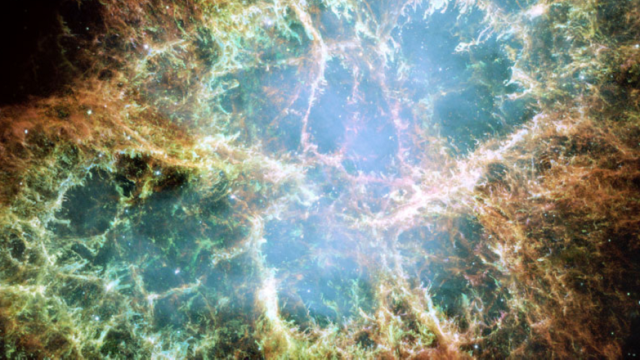In 1054 BCE, a new light blazed in the night sky, four times brighter than Venus. Chinese astronomers called it a “guest star,” but today we call it a supernova: the dying explosion of a massive star. The star that created the supernova of 1054 had been dead for 6500 years by the time the light of its explosion reached Earth.
A Cosmic Debris Cloud
The supernova was visible with the naked eye for three weeks before it faded back into the darkness, but in 1731, an English astronomer discovered a nebula — a glowing cloud of gas and dust — in the constellation Taurus, exactly where astronomers in China had seen the bright “guest star” 700 years before. Eventually, astronomers realised that the nebula was the remnant of the 1054 supernova, a cloud of debris expanding out into space.
Today, the Crab Nebula is about 10 light years across, but it’s expanding by about 1500 kilometers a second. Scientists are puzzled by its structure, because instead of a fairly smooth cloud, it’s made up of complex network of filaments, which seem to have less mass than would have been expelled in the supernova. And those filaments are expanding away from the center of the nebula faster than scientists would normally expect.

The Crab Pulsar
At its center is a tiny, dense mass made up mostly of neutrons, rotating very rapidly and emitting regular pulses of radiation across the whole electromagnetic spectrum. Pulsars like this one are what’s left behind when a star explodes. The material that doesn’t get ejected by the explosion collapses on itself. If there’s enough mass, the collapse forms a black hole, but smaller stars end up as pulsars.
At the center of the Crab Nebula, the Crab Pulsar is as massive as our Sun, but it’s only about 30 kilometers in diameter. It rotates about 30 times a second, and astronomers have used its pulses of radiation to study the Sun’s corona and the atmosphere of Saturn’s moon Titan, based on how radio and X-ray waves passed through or were blocked.
Thanks to observers in China nearly 1,000 years ago, the Crab Pulsar is the only one whose age we know precisely: it exploded into a supernova and collapsed into a pulsar 7,461 years ago.
The Hubble Space Telescope captured this dramatic image of the Crab Nebula, but if you have a telescope or a good set of binoculars, you can see it for yourself on a clear, dark night.
[NASA]
